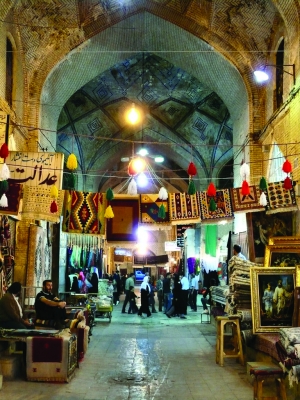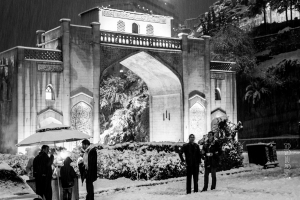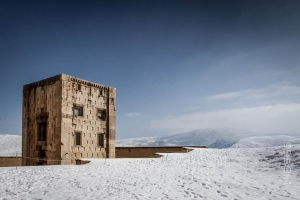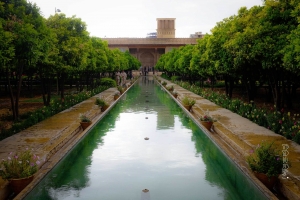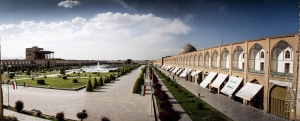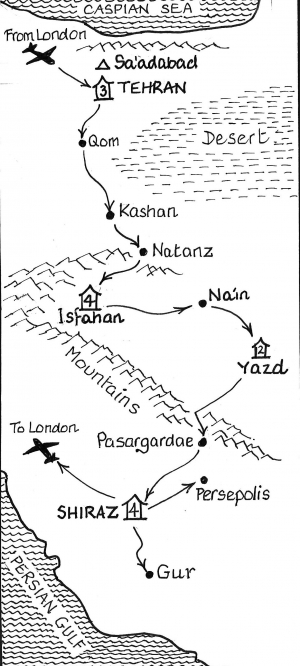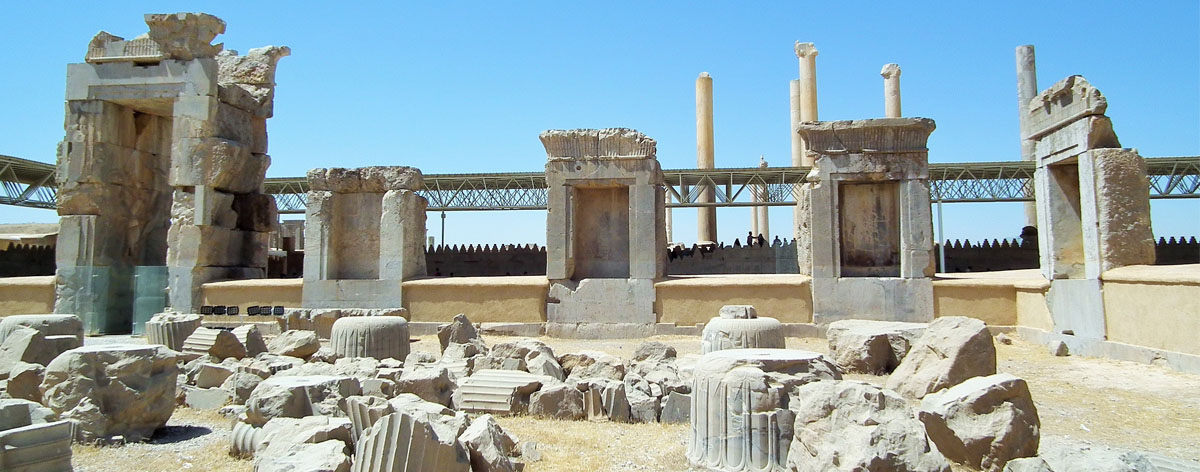
The Iran Experience
Persia from the Achaemenids to the Splendours of Islam
To be confirmed
The Iran Experience
Persia from the Achaemenids to the Splendours of Islam
Tour Introduction
Imagine Isfahan’s exotic golden and azure domes and minarets mounting lavishly decorated mosques through whose windows shines a rainbow of colours to illuminate a myriad of sumptuously geometrically tiled walls and ceilings; imagine standing before the colossal Grand Stairway framed by the exquisitely carved Xerxes’ Gateway before exploring the wonderful palaces and buildings of magnificent Persepolis, which stands testament to the glories of the ancient Achaemenid Empire; imagine raising your head to view, perched amidst the high cliffs, the tombs of Darius the Great and Xerxes I, victors at the Marathon and Thermopylae respectively; imagine joining some of the friendliest people on the planet for a beverage in their enchanted tea-houses and enjoy a smorgasbord of delicious food in wonderful restaurants; imagine a tour filled with history, culture, architecture, archaeology and gastronomy staying at some of the best hotels and led by a leading expert on Iran and the Achaemenid Empire. Then fulfil that imagination and join us on this awe-inspiring fortnight-long tour to Iran where you will encounter splendour such as you may have never seen before. With relations between the West and Iran better than ever, now is the time to visit this delightful country before the secret is out.
Our tour will be led by Dr Lindsay Allen of King’s College, London, whose expertise is in the Achaemenid Persian Empire and pre-Islamic Iran. She has travelled widely throughout the country in pursuing her research into Achaemenid kingship for her PhD and prior to writing her book ‘The Persian Empire: a history’ (for the British Museum Press, 2005). She has researched Achaemenid artefacts in the British Museum and the Metropolitan Museum of Art New York, and her current work on the history of archaeology in Iran has taken her to museums worldwide in search of little-known archives and Persian artefacts. At King’s she teaches on Alexander the Great, the Near East in the first millennium BC, Achaemenid Persia and Persepolis.
Please be aware that the tourism infrastructure in Iran is still developing and whilst the hotels on this tour are classed in Iran as five star, by European standards they may be regarded as four or, as in Yazd, three star hotels. However they will be clean, comfortable and wherever possible characterful and well-located.
Background
At the height of its power after the conquest of Egypt in the sixth century BCE, the Achaemenid Persian Empire was the largest the ancient world had ever seen. Its vast domain encompassed three continents: Asia, Africa and Europe and included the modern territories of Turkey, parts of Central Asia, Pakistan, Thrace and Macedonia, much of the Black Sea coastal regions, Afghanistan, Iraq, northern Saudi Arabia, Jordan, Israel, Lebanon, Syria, Egypt and Libya. Its historical influence went far beyond its territorial boundaries and, because of its wealth and strategic location, the empire was invaded, fractured, lost and re-established many times over thousands of years —by the Achaemenids, the Parthians, and the Sasanians until the seventh century, when Arabian tribesmen ushered in a new era of Islamic rule and beliefs. Ever since, Iranians have been finding ways to assert their identity as distinct from the rest of the Muslim and Arab world.
Highlights
- Expertly guided by Dr Lindsay Allen
- Wonderful Islamic architecture
- A full study of the Achaemenid Empire
- Tour packed with UNESCO listed sites
Itinerary
Day 1 – Depart. Fly London Gatwick to Tehran via Istanbul and check-in to our hotel for three nights.
Day 2 - Tehran. After the closures of the 1979 revolution, Iran’s museums and galleries set about rebuilding their tributes to one of the world’s oldest civilizations. Now they offer a rich insight into thousands of years of art and culture. We visit the National Museum; the Glass and Ceramics Museum housed in a beautiful Qajar era building; the Jewel Museum with the largest display of state jewels in the world and the Carpet Museum with a collection ranging from 500 BC to the modern day. Later in the afternoon we visit Golestan Palace, ‘The Palace of Flowers’, a 19th century Qajar royal abode.
Day 3 – Tehran. Drive to the north of the city to visit the Sa’adabad complex at the foot of the Alborz ranges. It was first the summer residence of Qajar kings, and later home to Reza Shah in the 1920s. In the afternoon explore Niavaran Palace, the primary residence of the last Shah, Mohammad Reza Pahlavi, and the Imperial family until the Iranian Revolution. We end with the small museum of Reza Abbasi which contains some exquisite objects and art from throughout Persian history.
Day 4 – Kashan, Natanz, Isfahan. Drive to Isfahan via Kashan and the UNESCO listed Bag e Fin Garden, surrounded by desert but supplied by aquifers of the Kakas Mountains. At Natanz we visit the beautiful 14th century mosque of Sheikh Abdussamad Esfahani, one of the best-preserved of all Ilkhanid-era buildings. Continue to Isfahan and check-in to our hotel for four nights.
Day 5 – Isfahan. The first of three days exploring this beautiful city, soaking up the splendour of the city’s exemplary Safavid architecture. Isfahan is brimming with sites of historic interest, some of which date back to pre-Islamic Iran. We start with the many beautiful bridges which span the Zayandeh River, Naqsh-e Jahan Square, Sheikh Lotfollah and Iman Mosques and the Ali Qapu Palace.
Day 6 – Isfahan. Further exploration of the city including the Armenian quarter, created when Shah Abbas I transported a colony of Christians from the town of Jolfa, and Vank Cathedral, the historical centre of the Armenian church in Iran. In the afternoon we visit the Safavid era Palaces of Chehel Sotoun and Hasht Behesht.
Day 7 – Isfahan. On our last day in the city we visit the 8th century Jameh mosque, the oldest preserved edifice of its type in Iran and a prototype for later mosque designs throughout Central Asia, and the Bazaar, developed in Shah Abbas’ 17th century building frenzy, although some parts are far older. Some free time to shop or relax in one of the city’s many teahouses.
Day 8 – Na’in, Yazd. Na’in is a pre-Islamic town on the edge of the Central Desert and an important crossroad on the trade routes across the province since Sassanid times. Unique to Na’in is the Jameh Mosque, one of the first four mosques built in Iran after the Arab invasion. Continue to Yazd and check-in to our hotel for two nights.
Day 9 – Yazd. A day to investigate this desert town with its warren-like streets and towering badgirs (wind-catchers). Yazd is the centre of Zoroastrianism in Iran and home to several sites of religious and historic significance - the Atashkadeh or Fire Temple chief among them, containing a sacred fire that has allegedly been burning since the 5th century AD.
Day 10 – Pasargardae. Pasargardae, first dynastic capital of the Achaemenid Kings and symbolic heart of the Persian Empire. The site is beautifully situated on the fertile Murghab plain surrounded by mountains. Continue to Shiraz and check-in to our hotel for the last four nights of the tour.
Day 11 – Firuzabad. Travel south to Firuzabad to explore the City of Gur, one of the largest cities in antiquity, originally planned within a perfect 2km circle; the Palace of Ardashir, founder of the Sasanian Empire; Qal'eh Dokhtar fortress built on a steep bluff overlooking the river; and bas reliefs from the time of Ardashir.
Day 12 – Shiraz. A day spent exploring Shiraz, regarded as one of the oldest cities in ancient Persia and the cultural capital of Iran. Visit the beautiful mausoleums of the great poets Hafez and Saadi; the house and gardens of the Narenjestan Ghavam; the extraordinarily beautiful Vakil Mosque; the Bazaar and bathhouse and the UNESCO-listed Bagh-e Eram garden, one of the oldest and most beautiful in Shiraz, and the Citadel, home of Karim Khan and the military centre of the Zand dynasty.
Day 13 – Persepolis. The magnificent palace complex of Parsa, Persepolis, partly cut out of the Mountain Kuh-e Rahmat, includes the Apadana, begun by Darius and finished by Xerxes; the Hundred-Column Hall; Palaces of Darius and Xerxes and their decorative reliefs; and the Treasury which served as an armoury and especially as a royal storehouse of the Achaemenid kings. In the afternoon visit the imposing site of Naqsh-e Rustam in the mountain range of Husain Kuh, where Darius the Great and his successors had their monumental tombs carved into the cliff.
Day 14 – Home. Early morning flight from Shiraz to London Gatwick via Istanbul.

